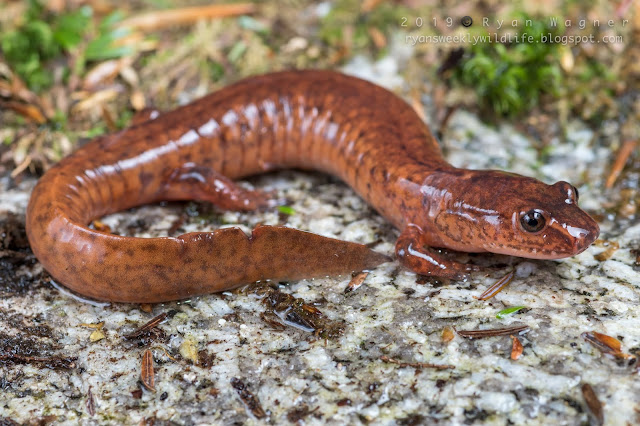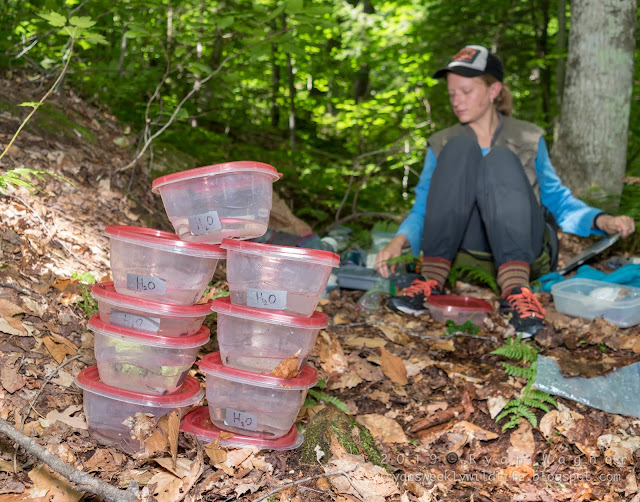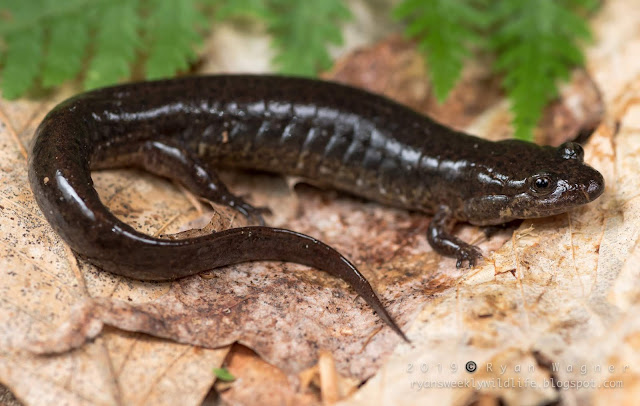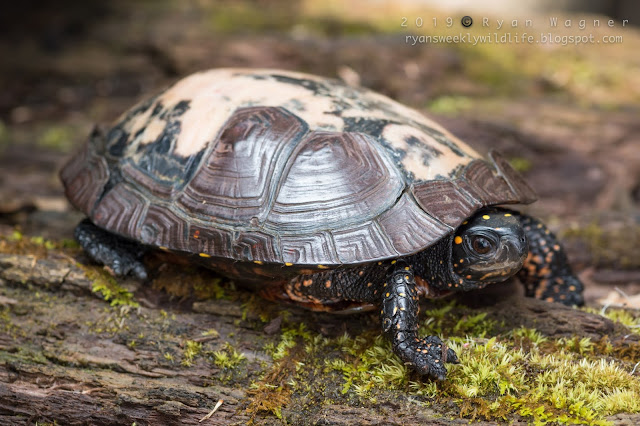 |
| Larval Northern Spring Salamander |
This might all sound a bit grotesque, but when it's your job to tally and identify all the roadkill amphibian species after every weather event, it gets to be pretty second nature. As a field biologist, I have amassed quite the array of inexplicably specific skills, that, as far as I can tell, have no “real world” analogue. If I’m not out on a rainy weekday night, identifying amphibian guts on a busy on-ramp, I’m out following turtles with little radio antenna backpacks up and down thorny hillsides in 95-degree heat. I’ve floated on my belly (donned in a full wet-suit, snorkel and all), in just over a foot of water, reaching my bite-size fingers into the dark, algae-encrusted crevices between rock slabs. I’ve counted, measured, and cataloged thousands of random bits of my surroundings from the amount of salts in the soil, to the percentage of moisture in the air. I’ve tallied rocks of a specific size, estimated how much sunshine is blocked by the leaves, and spun myself in circles trying to head exactly 144 degrees.
 |
| Adult Northern Spring Salamander |
Most of my stories recounting splattered frog legs, catching snot otters, or sexing snapping turtles are met with a mix of tentative curiosity or masked repulsion from the non-wildlife oriented. By their very nature, wildlife jobs take place off the radar of most people. There is always the odd run in with the nearby snake-poaching property owner, or the group of campers tromping through your study site, but for better or worse, most don’t seem to know the field exists. I’m used to the blank expressions when I declare I study reptiles and amphibians. The classic, “what can you do with that,” is the usual retort. Some seem to imagine that a career in wildlife means you get to play with cute and fuzzy animals all day, and while that is sometimes true (minus the fuzzy in my case) there is a lot more to jobs in wildlife and ecology than one might expect.
 |
| A wood frog found at Hubbard Brook Experimental Forest |
Hubbard Brook is something else entirely. Imagine a neighborhood with a half dozen buildings and a large lake for a backyard. Every morning, instead of driving to the office dressed in a suit and tie, brief case in hand, everyone here walks out the front door clad in muddy hiking boots and polyester pants, the day’s equipment tucked under each arm, and heads for the woods. There are crews studying soils, trees, birds, water, vegetation, amphibians, you name it. Potlucks and science talks are held every week. During two days in July, researchers, professors, land managers, graduate students, and undergrads travel from all over the country and the world to take part in ‘The Meetings,’ a conference discussing current research and the state of the forest. I’ve never been anywhere that felt like such a hub for environmental science.
What makes Hubbard Brook such a
research Mecca, are the long-term, large-scale experiments that have been
ongoing here since the 60s. Located in
Central New Hampshire in the southern part of the White Mountains, this 7,800
acre valley has entire watersheds devoted to answering specific questions regarding
natural and human disturbances. In the 1960s,
70s, and 80s, several watersheds were systematically deforested to varying
degrees to determine the effects on forest regeneration, stream flow, and
nutrient cycling. In 1999, another watershed had 45 tons of calcium dropped
by helicopter to offset the effects of acid rain. Other, large scale experiments have included
artificial ice storms, climate change monitoring, and impacts of disease and
invasive species on plant and animal communities. The remaining water sheds have been left as
controls and are intensively monitored for comparison with these
landscape-scale test tubes.
I was hired as an REU (Research
Experience for Undergraduates) student for a project working with stream
salamanders at Hubbard Brook. Upon
arrival at our field house, I was baffled to find the walls decorated by half a
dozen photographs of what appeared to be outhouses. Much to my embarrassment, it was soon made
clear that these were not toilets, conveniently positioned at the top of each
of our field sites, but weirs. The ‘gage
house,’ which I had mistaken for a latrine, contains a complex system of
pulleys and measuring equipment used to record changes in water flow over
time. Like something out of a disaster
movie, a hydrograph scratches a series of jagged lines onto a sheet of paper fed
slowly through the machine as the water level rises and falls.
 |
| Northern Spring Salamander. |
There are nine weirs in the Hubbard Brook valley, each measuring the flow of a different stream. Thanks to the long-term data these weirs collect, scientists can test hypotheses regarding differences in stream flow rate as well as monitor water levels on an hourly basis. Stream flashiness is of particular interest to wildlife biologists studying stream dwelling organisms. A “flashy” stream swells rapidly during a storm before dropping back to baseline levels just hours after the precipitation has passed. This rapid influx of water can modify habitats by overturning rocky substrate and woody debris, influencing survival of everything from macroinvertebrates to fish and amphibians.
 |
| A large Northern Spring Salamander. |
Maddy is a first year PhD student with short, brown hair, a can-do attitude, and a keen sense of adventure—she once told me about a personal bet to try every rope swing she sees. Maddy conducted her Master’s research on wood turtles in Minnesota and is now using the closely studied hydrology of Hubbard Brook as a proxy for the impacts of climate change. Leah Swartz did her Master's with Dr. Lowe and is now manager of his lab. She has a tall, runner’s physique and a strict attention to detail. Leah is helping me craft my own independent project (one of the perks of being an REU student) looking at the impacts of fish predation on salamander stress levels.
While I recuperate on the couch
after a “short” eight-hour day in the field, Maddy and Leah typically head out
for an afternoon run and swim, or the occasional rock-climbing session. How they find the time and energy, I don’t
know. These two are more like ultimate
rocky mountain tour guides than any biologist I’ve ever met.
With the help of telemetry, Maddy, is getting to know the day-to-day lives of spring salamanders better than just about any other scientist. After inserting 12-millimeter PIT tags beneath the skin of three dozen spring and dusky salamanders, she has been able to record their fine scale movements and habitat preferences. A telemetry wand, reminiscent of a metal detector, can locate these PIT tags from as much as 30 centimeters away as it is waved over the rocky substrate of the stream bed. This is only her first year of data collection, but hopefully these intimate observations will help us understand what environmental factors contribute to reduced survival in salamanders.
With the help of telemetry, Maddy, is getting to know the day-to-day lives of spring salamanders better than just about any other scientist. After inserting 12-millimeter PIT tags beneath the skin of three dozen spring and dusky salamanders, she has been able to record their fine scale movements and habitat preferences. A telemetry wand, reminiscent of a metal detector, can locate these PIT tags from as much as 30 centimeters away as it is waved over the rocky substrate of the stream bed. This is only her first year of data collection, but hopefully these intimate observations will help us understand what environmental factors contribute to reduced survival in salamanders.
 |
| A larval Northern Spring Salamander. |
 |
| Leah Swartz with Tupperware full of salamanders. |
We begin each survey staggered along the stream every 100 meters, armed with zip-lock bags, pockets full of flagging, and a tally counter. I move along slowly, hopping from one granite boulder to the next, flipping large, rounded rocks every meter. Two hands are essential to keep these rounded stones from spinning in their sockets and crushing anything that might be lurking below. Any rock, no matter how inconveniently positioned, could hide a salamander. I grip the rough, almost sharp, texture of one particularly good-looking rock, and gently lift it out of the water. An elongate, silvery body wriggles nervously in the clear, gently flowing current. With one hand, I cut off the salamander’s escape and usher it gently towards my open plastic bag held flush with the stream bed. The salamander darts to one side of my trap, then to the other. After a few moments of finessing with the stubborn amphibian, it enters the bag just far enough for me to scoop it out of the water. I mark its rock with a piece of flagging and record the meter location and habitat.
 |
| Inserting a PIT tag into an adult Northern Spring Salamander. |
We record weight, snout-vent length, sex, and note tail condition before snipping off a small piece to be preserved for DNA analysis. This is of little consequence to the salamander, as they can regrow the tail in a few months’ time. After processing, we allow each salamander time to recover in a fresh water bath before returning them to the very same rock where they were found. The whole affair takes just a few minutes for the sallies, but catching and processing 50 salamanders can take us all day.
 |
| Northern Spring Salamander in Stream Habitat. |
These past four months at Hubbard Brook have helped me grow immensely as a young scientist. I will miss waking up to the mournful calls of loons each morning and looking for moose in the evenings. Hubbard Brook has been pumping out science and scientists alike for decades and I feel proud to be a part of that legacy if only in a small way.
I know I will have to return to this amazing community of researchers and field technicians soon.
Thanks for reading!
Keep living the field life
RBW













